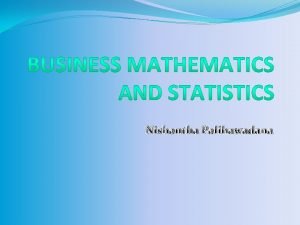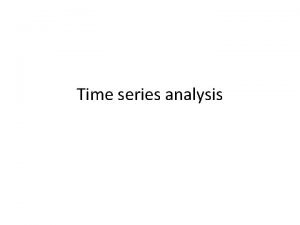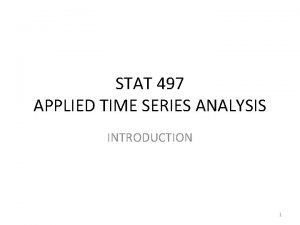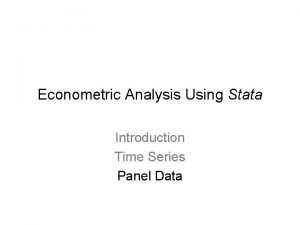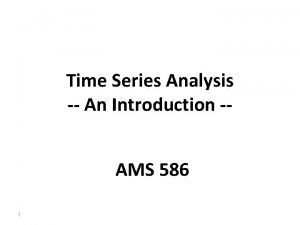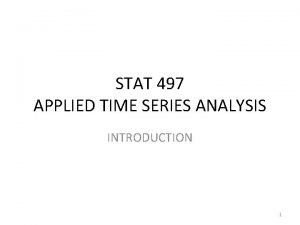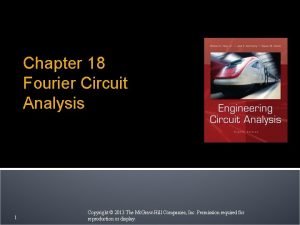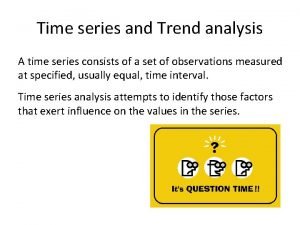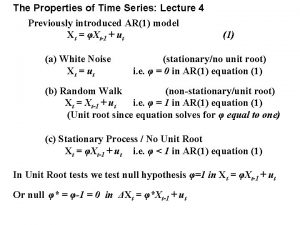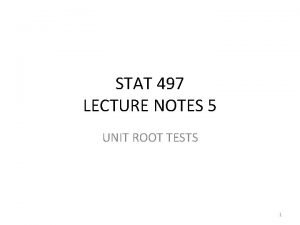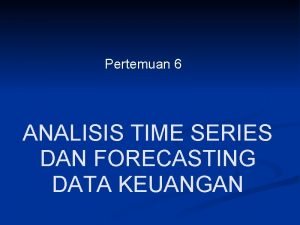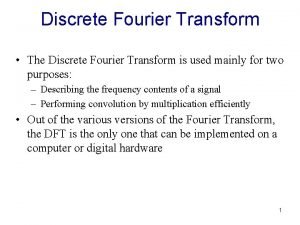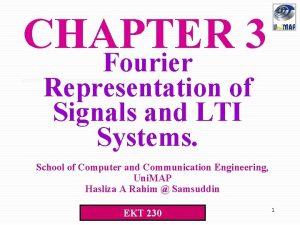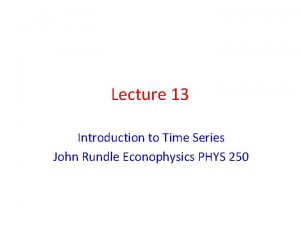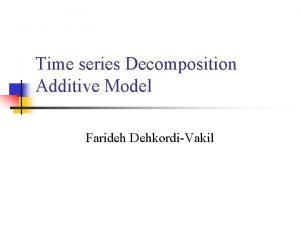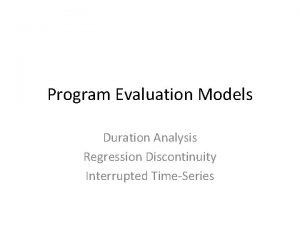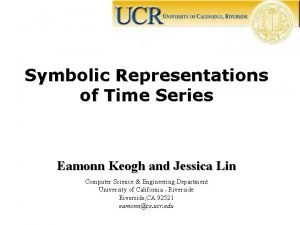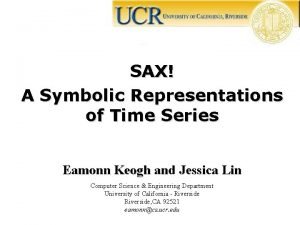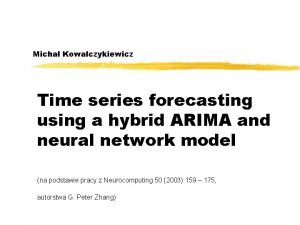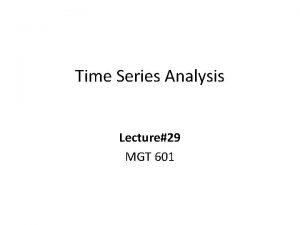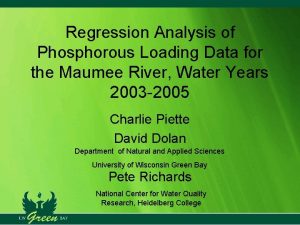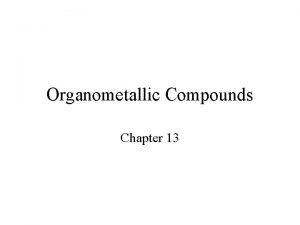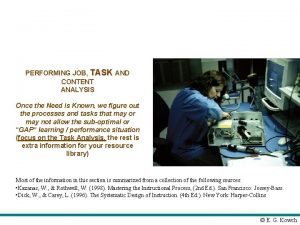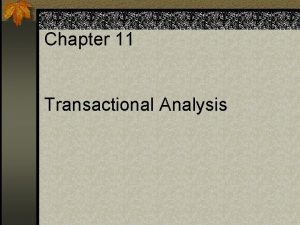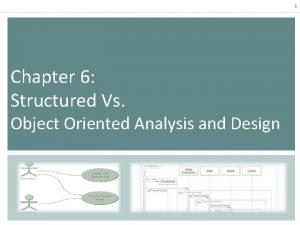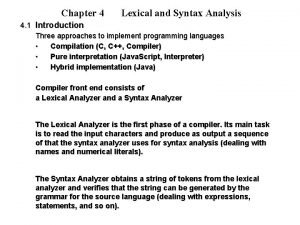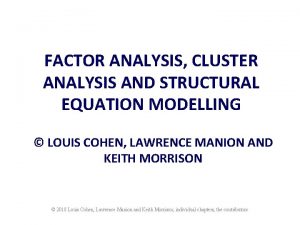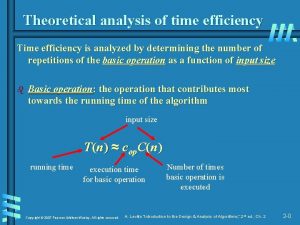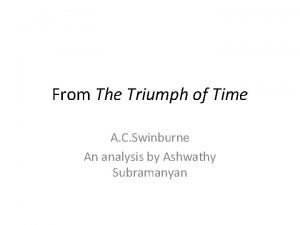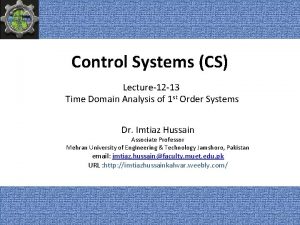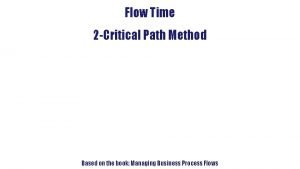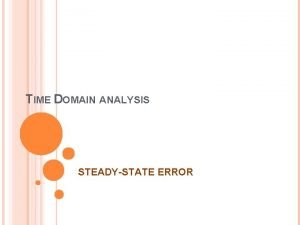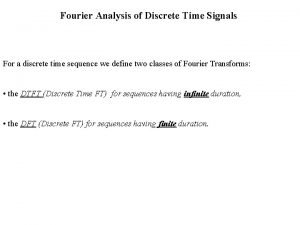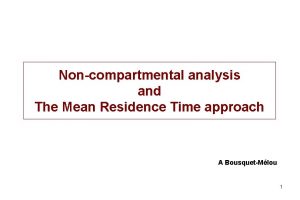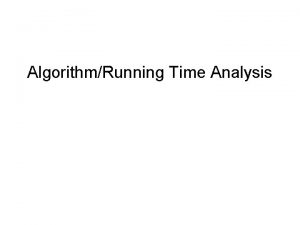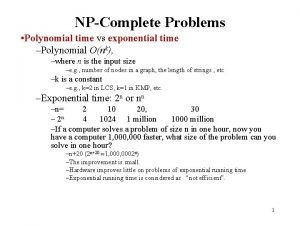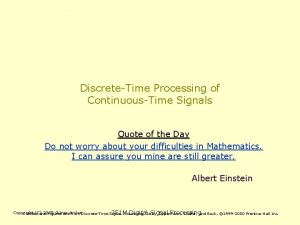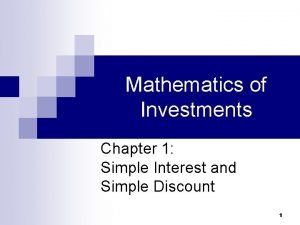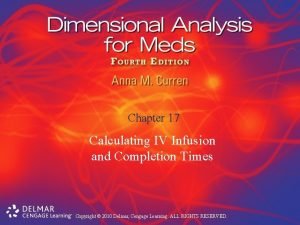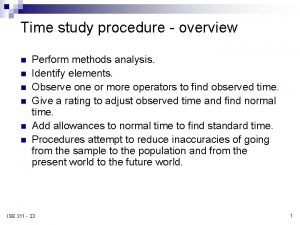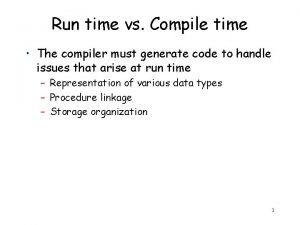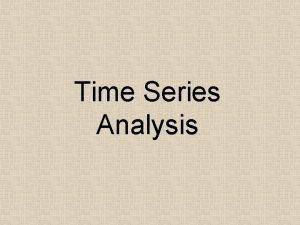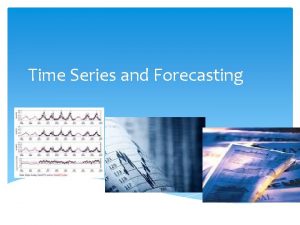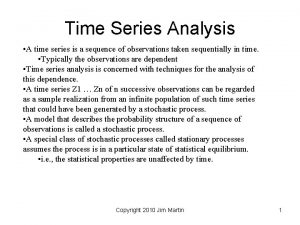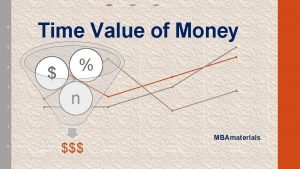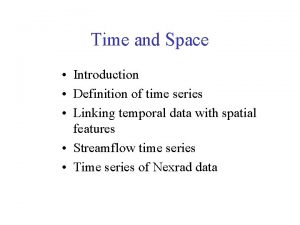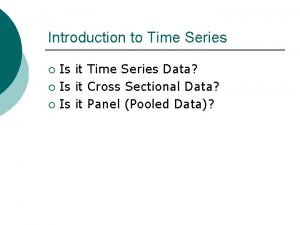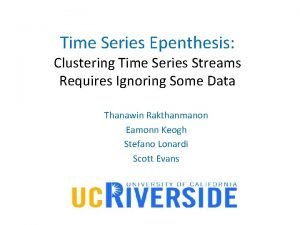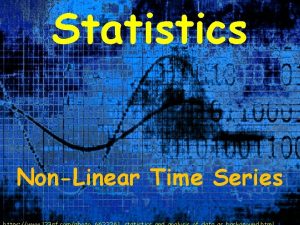Time Series Analysis Definition A Time Series xt







![Definition: m(t) = mean value function of {xt : t T} = E[xt] for Definition: m(t) = mean value function of {xt : t T} = E[xt] for](https://slidetodoc.com/presentation_image_h2/8ba807312d547fdbc2afd74cf979869b/image-8.jpg)






















































































- Slides: 94

Time Series Analysis

Definition A Time Series {xt : t T} is a collection of random variables usually parameterized by 1) the real line T = = (-∞, ∞) 2) the non-negative real line T = + = [0, ∞) 3) the integers T = = {…, -2, -1, 0, 1, 2, …} 4) the non-negative integers T = + = {0, 1, 2, …}

If xt is a vector, the collection of random vectors {xt : t T} is a multivariate time series or multi-channel time series. If t is a vector, the collection of random variables {xt : t T} is a multidimensional “time” series or spatial series. (with T = k= k-dimensional Euclidean space or a kdimensional lattice. )

Example of spatial time series

The project • Buoys are located in a grid across the Pacific ocean • Measuring – Surface temperature – Wind speed (two components) – Other measurements The data is being collected almost continuously The purpose is to study El Nino

Technical Note: The probability measure of a time series is defined by specifying the joint distribution (in a consistent manner) of all finite subsets of {xt : t T}. i. e. marginal distributions of subsets of random variables computed from the joint density of a complete set of variables should agree with the distribution assigned to the subset of variables.

The time series is Normal if all finite subsets of {xt : t T} have a multivariate normal distribution. Similar statements are true for multi-channel time series and multidimensional time series.
![Definition mt mean value function of xt t T Ext for Definition: m(t) = mean value function of {xt : t T} = E[xt] for](https://slidetodoc.com/presentation_image_h2/8ba807312d547fdbc2afd74cf979869b/image-8.jpg)
Definition: m(t) = mean value function of {xt : t T} = E[xt] for t T. s(t, s) = covariance function of {xt : t T} = E[(xt - m(t))(xs - m(s))] for t, s T.

For multichannel time series m(t) = mean vector function of {xt : t T} = E[xt] for t T and S(t, s) = covariance matrix function of {xt : t T} = E[(xt - m(t))(xs - m(s))′] for t, s T. The ith element of the k × 1 vector m(t) mi(t) =E[xit] is the mean value function of the time series {xit : t T} The i, jth element of the k × k matrix S(t, s) sij(t, s) =E[(xit - mi(t))(xjs - mj(s))] is called the cross-covariance function of the two time series {xit : t T} and {xjt : t T}

Definition: The time series {xt : t T} is stationary if the joint distribution of xt 1, xt 2, . . . , xtk is the same as the joint distribution of xt 1+h , xt 2+h , . . . , xtk+h for all finite subsets t 1, t 2, . . . , tk of T and all choices of h.

Definition: The multi-channel time series {xt : t T} is stationary if the joint distribution of xt 1, xt 2, . . . , xtk is the same as the joint distribution of xt 1+h , xt 2+h , . . . , xtk+h for all finite subsets t 1, t 2, . . . , tk of T and all choices of h.

Definition: The multidimensional time series {xt : t T} is stationary if the joint distribution of xt 1, xt 2, . . . , xtk is the same as the joint distribution of xt 1+h , xt 2+h , . . . , xtk+h for all finite subsets t 1, t 2, . . . , tk of T and all choices of h.

The distribution of observations at these points in time same as The distribution of observations at these points in time Time Stationarity

Some Implication of Stationarity If {xt : t T} is stationary then: 1. The distribution of xt is the same for all t T. 2. The joint distribution of xt, xt + h is the same as the joint distribution of xs, xs + h.

Implication of Stationarity for the mean value function and the covariance function If {xt : t T} is stationary then for t T. m(t) = E[xt] = m and for t, s T. s(t, s) = E[(xt - m)(xs - m)] = E[(xt+h - m)(xs+h - m)] = E[(xt-s - m)(x 0 - m)] with h = -s = s(t-s)

If the multi-channel time series{xt : t T} is stationary then for t T. m(t) = E[xt] = m and for t, s T S(t, s) = S(t-s) Thus for stationary time series the mean value function is constant and the covariance function is only a function of the distance in time (t – s)

If the multidimensional time series {xt : t T} is stationary then for t T. m(t) = E[xt] = m and for t, s T. s(t, s) = E[(xt - m)(xs - m)] = s(t-s) (called the Covariogram) Variogram V(t, s) = V(t - s) = Var[(xt - xs)] = E[(xt - xs)2] = Var[xt] + Var[xs] – 2 Cov[xt, xs] = 2[s(0) - s(t-s)]

Definition: r(t, s) = autocorrelation function of {xt : t T} = correlation between xt and xs. for t, s T. If {xt : t T} is stationary then r(h) = autocorrelation function of {xt : t T} = correlation between xt and xt+h.

Definition: The time series {xt : t T} is weakly stationary if: m(t) = E[xt] = m for all t T. and s(t, s) = s(t-s) for all t, s T. or r(t, s) = r(t-s) for all t, s T.

Examples Stationary time series

1. Let X denote a single random variable with mean m and standard deviation s. In addition X may also be Normal (this condition is not necessary) Let xt = X for all t T = { …, , -2, -1, 0, 1, 2, …} Then E[xt] = m = E[X] for t T and s(h) = E[(xt+h - m)(xt - m)] = Cov(xt+h, xt ) = E[(X - m)] = Var(X) = s 2 for all h.

Excel file illustrating this time series

2. Suppose {xt : t T} are identically distributed and uncorrelated (independent). T = { …, , -2, -1, 0, 1, 2, …} Then E[xt] = m = E[X] for t T and s(h) = E[(xt+h - m)(xt - m)] = Cov(xt+h, xt )

The auto correlation function: Comment: If m = 0 then the time series {xt : t T} is called a white noise time series. Thus a white noise time series consist of independent identically distributed random variables with mean 0 and common variance s 2

Excel file illustrating this time series

3. Suppose X 1, … , Xk and Y 1, Y 2, … , Yk are independent random variables with Let l 1, l 2, … lk denote k values in (0, p) For any t T = { …, , -2, -1, 0, 1, 2, …}

Excel file illustrating this time series

Then

Hence

Hence using cos(A – B) = cos(A) cos(B) + sin(A) sin(B) and

4. The Moving Average Time series of order q, MA(q) Let a 0 =1, a 2, … aq denote q + 1 numbers. Let {ut|t T} denote a white noise time series with variance s 2. – independent – mean 0, variance s 2. Let {xt|t T} be defined by the equation. Then {xt|t T} is called a Moving Average time series of order q. MA(q)

Excel file illustrating this time series

The mean The auto covariance function


The autocovariance function for an MA(q) time series The autocorrelation function for an MA(q) time series

5. The Autoregressive Time series of order p, AR(p) Let b 1, b 2, … bp denote p numbers. Let {ut|t T} denote a white noise time series with variance s 2. – independent – mean 0, variance s 2. Let {xt|t T} be defined by the equation. Then {xt|t T} is called a Autoregressive time series of order p. AR(p)

Excel file illustrating this time series

Comment: An Autoregressive time series is not necessarily stationary. Suppose {xt|t T} is an AR(1) time series satisfying the equation: where {ut|t T} is a white noise time series with variance s 2. i. e. b 1 = 1 and d = 0.

but and is not constant. A time series {xt|t T} satisfying the equation: is called a Random Walk.

Derivation of the mean, autocovariance function and autocorrelation function of a stationary Autoregressive time series We use extensively the rules of expectation

Assume that the autoregressive time series {xt|t T} be defined by the equation: is stationary. Let m = E(xt). Then

The Autocovariance function, s(h), of a stationary autoregressive time series {xt|t T}can be determined by using the equation: Thus

Hence where

Now

The equations for the autocovariance function of an AR(p) time series etc

Or using s(-h) = s(h) and for h > p

Use the first p + 1 equations to find s(0), s(1) and s(p) Then use To compute s(h) for h > p

The Autoregressive Time series of order p, AR(p) Let b 1, b 2, … bp denote p numbers. Let {ut|t T} denote a white noise time series with variance s 2. – independent – mean 0, variance s 2. Let {xt|t T} be defined by the equation. Then {xt|t T} is called a Autoregressive time series of order p. AR(p)

If the autoregressive time series {xt|t T} be defined by the equation: is stationary. Then

The Autocovariance function, s(h), of a stationary autoregressive time series {xt|t T} be defined by the equation: Satisfy the equations:

Yule Walker Equations and for h > p

Use the first p + 1 equations (the Yole-Walker Equations) to find s(0), s(1) and s(p) Then use To compute s(h) for h > p

The Autocorrelation function, r(h), of a stationary autoregressive time series {xt|t T}: The Yule walker Equations become:

and for h > p

To find r(h) and s(0): solve for r(1), …, r(p) Then for h > p

Example Consider the AR(2) time series: xt = 0. 7 xt – 1+ 0. 2 xt – 2 + 4. 1 + ut where {ut} is a white noise time series with standard deviation s = 2. 0 White noise ≡ independent, mean zero (normal) Find m, s(h), r(h)

To find r(h) solve the equations: or thus

for h > 2 This can be used in sequence to find: results

To find s(0) use: or = 17. 778

To find s(h) use: To find m use:

An explicit formula for r(h) Auto-regressive time series of order p.

Consider solving the difference equation: This difference equation can be solved by: Setting up the polynomial where r 1, r 2, … , rp are the roots of the polynomial b(x).

The difference equation has the general solution: where c 1, c 2, … , cp are determined by using the starting values of the sequence r(h).

Example: An AR(1) time series for h > 1 and

The difference equation Can also be solved by: Setting up the polynomial Then a general formula for r(h) is:

Example: An AR(2) time series for h > 1

Setting up the polynomial

Then a general formula for r(h) is: For h = 0 and h = 1. Solving for c 1 and c 2.

Solving for c 1 and c 2. and Then a general formula for r(h) is:

If are real and is a mixture of two exponentials

If are complex conjugates. Some important complex identities

The above identities can be shown using the power series expansions:

Some other trig identities:


Hence


a damped cosine wave

Example Consider the AR(2) time series: xt = 0. 7 xt – 1+ 0. 2 xt – 2 + 4. 1 + ut where {ut} is a white noise time series with standard deviation s = 2. 0 The correlation function found before using the difference equation: r(h) = 0. 7 r(h – 1) + 0. 2 r(h – 2)

Alternatively setting up the polynomial

Thus

Another Example Consider the AR(2) time series: xt = 0. 2 xt – 1 - 0. 5 xt – 2 + 4. 1 + ut where {ut} is a white noise time series with standard deviation s = 2. 0 The correlation function found before using the difference equation: r(h) = 0. 2 r(h – 1) - 0. 5 r(h – 2)

Alternatively setting up the polynomial

Thus where and


a damped cosine wave

Conditions for stationarity Autoregressive Time series of order p, AR(p)

If b 1 = 1 and d = 0. The value of xt increases in magnitude and ut eventually becomes negligible. The time series {xt|t T} satisfies the equation: The time series {xt|t T} exhibits deterministic behaviour.

Let b 1, b 2, … bp denote p numbers. Let {ut|t T} denote a white noise time series with variance s 2. – independent – mean 0, variance s 2. Let {xt|t T} be defined by the equation. Then {xt|t T} is called a Autoregressive time series of order p. AR(p)

Consider the polynomial with roots r 1, r 2 , … , rp then {xt|t T} is stationary if |ri| > 1 for all i. If |ri| < 1 for at least one i then {xt|t T} exhibits deterministic behaviour. If |ri| ≥ 1 and |ri| = 1 for at least one i then {xt|t T} exhibits non-stationary random behaviour.

Special Cases: The AR(1) time Let {xt|t T} be defined by the equation.

Consider the polynomial with root r 1= 1/b 1 1. {xt|t T} is stationary if |r 1| > 1 or |b 1| < 1. 2. If |ri| < 1 or |b 1| > 1 then {xt|t T} exhibits deterministic behaviour. 3. If |ri| = 1 or |b 1| = 1 then {xt|t T} exhibits nonstationary random behaviour.

Special Cases: The AR(2) time Let {xt|t T} be defined by the equation.

Consider the polynomial where r 1 and r 2 are the roots of b(x) 1. {xt|t T} is stationary if |r 1| > 1 and |r 2| > 1. This is true if b 1+b 2 < 1 , b 2 –b 1 < 1 and b 2 > -1. These inequalities define a triangular region for b 1 and b 2. If |ri| < 1 or |b 1| > 1 then {xt|t T} exhibits deterministic behaviour. 3. If |ri| ≥ 1 for i = 1, 2 and |ri| = 1 for at least on i then {xt|t T} exhibits non-stationary random behaviour.

Patterns of the ACF and PACF of AR(2) Time Series In the shaded region the roots of the AR operator are complex b 2
 Sequence definition
Sequence definition Main objectives of time series analysis
Main objectives of time series analysis Time series analysis
Time series analysis Time series analysis using stata
Time series analysis using stata Importance of time series
Importance of time series Stochastic process
Stochastic process Pooled time series
Pooled time series Time series definition
Time series definition Maclaurin series vs taylor series
Maclaurin series vs taylor series Balmer series lyman series
Balmer series lyman series Serie de taylor
Serie de taylor Taylor frederick
Taylor frederick Ibm p series servers
Ibm p series servers Shunt shunt feedback amplifier
Shunt shunt feedback amplifier Series aiding and series opposing
Series aiding and series opposing Arithmetic sequence sum formula
Arithmetic sequence sum formula What is elapsed time
What is elapsed time Fourier series circuit analysis
Fourier series circuit analysis Irregular variation in time series example
Irregular variation in time series example Unit root time series
Unit root time series Unit root test lecture notes
Unit root test lecture notes Analisis time series pada laporan keuangan
Analisis time series pada laporan keuangan Jocelyn barker
Jocelyn barker Time series binning
Time series binning Pengertian dari data series adalah
Pengertian dari data series adalah Aggregating time series data
Aggregating time series data Time series further maths
Time series further maths Discrete time fourier series
Discrete time fourier series Discrete fourier transform
Discrete fourier transform Magnitude and phase response
Magnitude and phase response Centered moving average example
Centered moving average example Covariance of two time series
Covariance of two time series Spectrum unternet
Spectrum unternet Time series for dummies
Time series for dummies Additive model time series
Additive model time series Interrupted time series vs regression discontinuity
Interrupted time series vs regression discontinuity Time series motifs
Time series motifs Sax time series
Sax time series Time series forecasting
Time series forecasting Fourier series linearity
Fourier series linearity Time series shapelets
Time series shapelets The time series consists of
The time series consists of Teknik analisis data time series
Teknik analisis data time series Time series gcse
Time series gcse Scala time series
Scala time series Condensation copolymers
Condensation copolymers 18 electron rule
18 electron rule Homologous series
Homologous series What are structured analysis tools?
What are structured analysis tools? Cuckoo sandbox vmware image
Cuckoo sandbox vmware image Difference between content and discourse analysis
Difference between content and discourse analysis Differences between error analysis and contrastive analysis
Differences between error analysis and contrastive analysis Types of intralingual errors
Types of intralingual errors Fact finding methods in system analysis and design
Fact finding methods in system analysis and design Content analysis and task analysis
Content analysis and task analysis Transactional analysis criticism
Transactional analysis criticism Structured analysis vs object oriented analysis
Structured analysis vs object oriented analysis Lex
Lex Data quality is always a concern with secondary data
Data quality is always a concern with secondary data Feasibility analysis matrix
Feasibility analysis matrix Kmo test
Kmo test Theoretical analysis of time efficiency
Theoretical analysis of time efficiency Swinburne
Swinburne Time domain analysis of control system
Time domain analysis of control system Time impact analysis
Time impact analysis Time structuring in transactional analysis
Time structuring in transactional analysis Time structuring in transactional analysis
Time structuring in transactional analysis Theoretical flow time for alternative paths
Theoretical flow time for alternative paths Robert herrick to the virgins to make much of time analysis
Robert herrick to the virgins to make much of time analysis Steady state error
Steady state error Fourier analysis of discrete time signals
Fourier analysis of discrete time signals Time slice windows analysis
Time slice windows analysis Mean resistance time
Mean resistance time Running time analysis
Running time analysis Takt time vs cycle time
Takt time vs cycle time Length bias vs lead time bias
Length bias vs lead time bias Lead time bias vs length time bias
Lead time bias vs length time bias Polynomial time vs exponential time
Polynomial time vs exponential time Military time graph
Military time graph It's time to speak
It's time to speak Lead time bias vs length time bias
Lead time bias vs length time bias Setup time and hold time in digital electronics
Setup time and hold time in digital electronics Dorothea tanning biography
Dorothea tanning biography Discrete time processing of continuous time signals
Discrete time processing of continuous time signals 24 hour format clock
24 hour format clock How to find principal amount
How to find principal amount Graphs that compare distance and time are called
Graphs that compare distance and time are called Calculating iv infusion rate
Calculating iv infusion rate Once upon a time a long long time ago
Once upon a time a long long time ago Seek time in magnetic disk
Seek time in magnetic disk Techniques of work study
Techniques of work study How to perform a time study
How to perform a time study Sixty percent of the time it works every time
Sixty percent of the time it works every time Build time vs compile time
Build time vs compile time Once upon a time a long long time ago begins the story
Once upon a time a long long time ago begins the story
